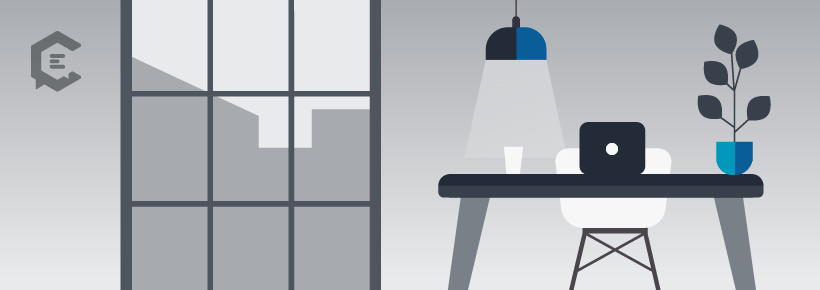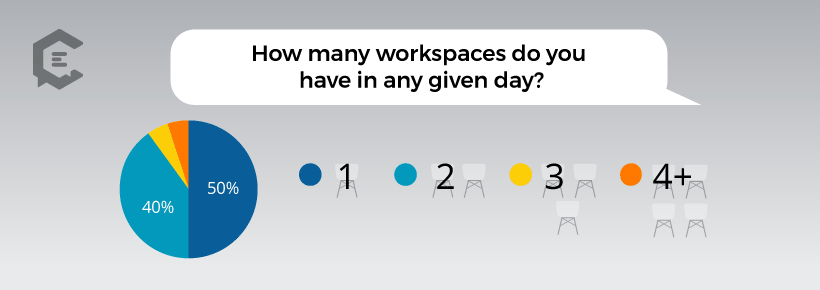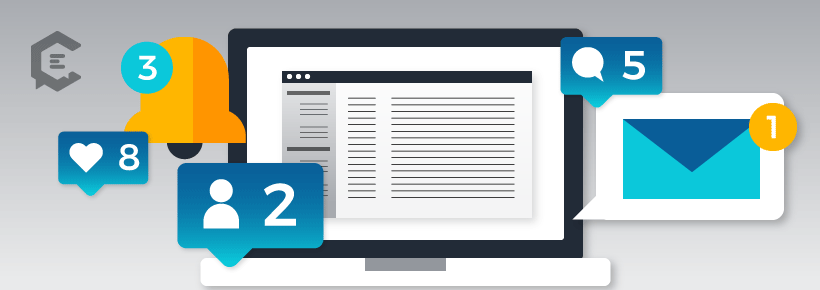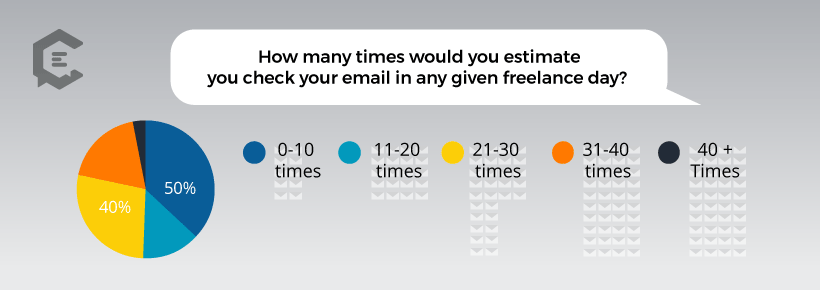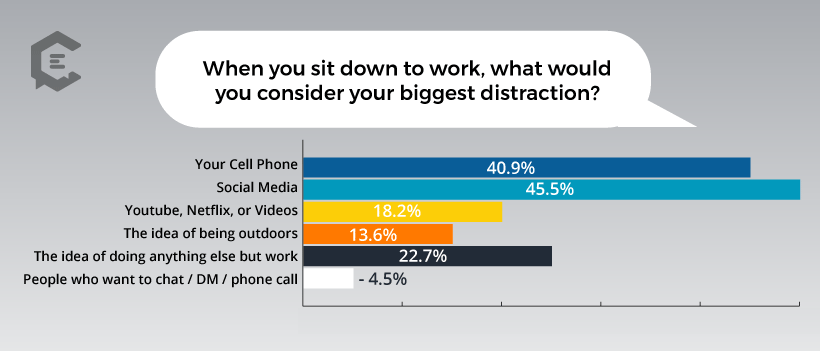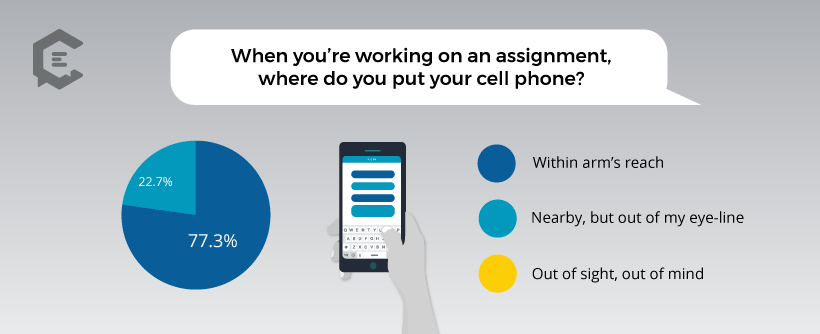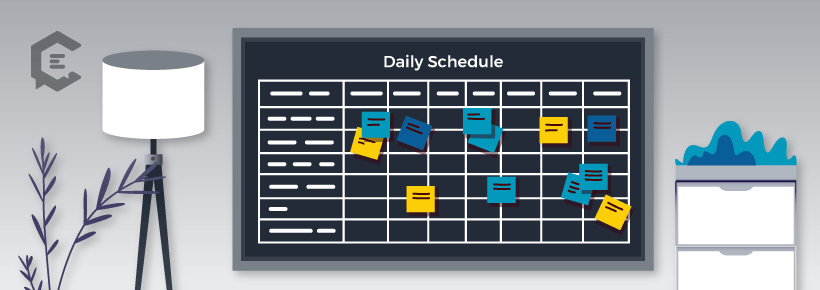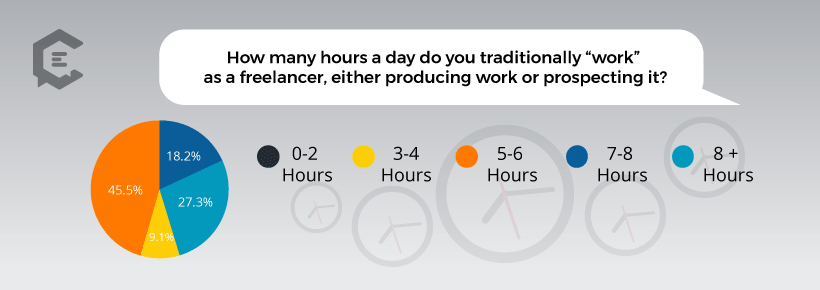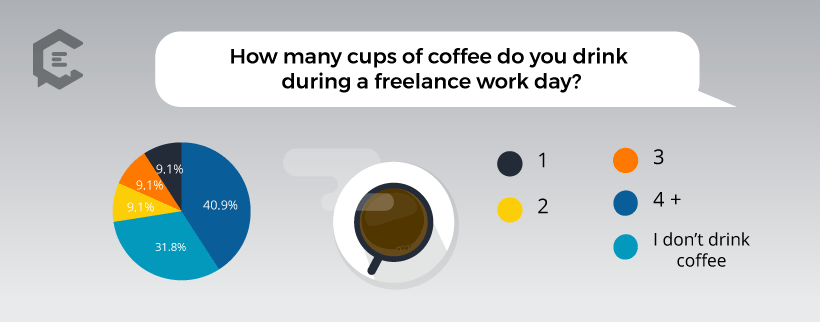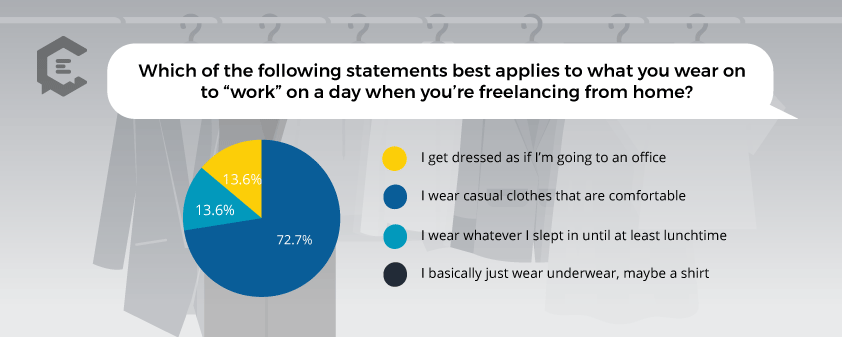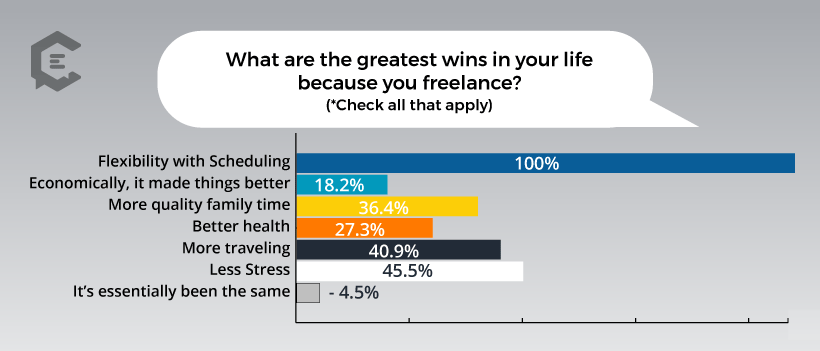Let’s get one thing out of the way to start: According to this revealing yet unscientific survey I did for Data Week, no freelancers work in their underpants all day, debunking a popular myth that if you work from home, you often do so wearing little to nothing.
Traditionally, most freelancers do work in a bubble in fact, isolated from the world of office conference rooms and the idle chitchat that gets spat at coffeemakers across America. For freelancers, human contact is generally limited to email, Slack and the occasional Amazon delivery person. Clients generally don’t need freelancers onsite, which for the freelancer is usually fine because being a shut-away can be a preferred part of the gig. An exemption from morning commutes, micromanagers and office politics that allow the freelancer to focus on the task at hand, without the “noise” that can derail a productive day at the keyboard.
That’s why I thought “Data Week” would be a good time to explore the one thing that binds all freelancers together: work habits. Not the process of writing, editing, or designing per se… We’ll leave that for another poll. The process of how we work, the time we set time aside, what we wear, listen to, drink, and how we stave off — or embrace to our detriment — the elements of distraction.
I thought it would be fun to see how other freelancers do it, if just to compare. To see what works best for them, productivity-wise, lifestyle-wise, sanity-wise. Work habits we’ve all cultivated without a boss or a bullpen, or Ted from accounting to F it all up.
Having said that, what works for one person might not work for another, as this survey proved. Some of the results were predictable, others surprising. Many were indicative of trends reflecting how technology has changed or influenced our lives.
This survey was designed not to be science, but instead, as a general reference point to help the relatively untethered feel connected. To each other… and themselves. After all, the more you know about yourself and how you thrive, the more you can grow your freelance business and get on a path to greater riches through knowledge, empowerment and deep understanding.
True, freelancers might not be able to all co-work together in some massive, utopic freelancer paradise…
But that doesn’t mean we should all feel alone.
Now, the results!
Worth Noting: Of those polled, 73%* classified themselves as “full-time freelancers” versus 27% who said they were “freelancers looking for a full-time job,” indicating that some of their time is likely spent job seeking.
*Some survey results in this article have been rounded up or down to spare us all the use of decimals.
Bucket #1: The work space
One of the top reasons people choose the freelance life is so they don’t have to be in an office 40-60 hours a week. The desire to work outside the world of fluorescent-lit cubicle farms, catty coworkers and roving eyeballs is a real thing. But where, in the desire to be liberated from traditional desk jobs, do freelancers actually work and how often do they change it up once they plop down?
Well, according to the survey results, the concept of being a “digital nomad” doesn’t necessarily apply to the daily routine (as much as a lifestyle choice), with half of freelancers staying put in one workspace for most of their day… with 41% copping to two.
There were, however, roughly 9% who said they work from three or more workspaces in any given day, and I anticipate that number will only grow over time as freelancing continues to soar in popularity becoming more of the cultural norm.
In a related survey result, it should come as no surprise that 64% of poll takers answered the question “Where do you find it easiest to work when you work remotely?” by answering “home office” followed by “Anywhere with WiFi” at 18%. This majority was offset by the coffeehouse crew (9%) and a smaller amount who wrote in “shared workspace,” which interestingly enough, wasn’t a supplied answer and shines a light on a millennial-fueled trend that’s only getting more popular by the day.
Bucket #2: Distractions
Remember the days when the mail came once per day, you got it, opened it and waited for the next day (repeat cycle)? Most reading probably don’t, but believe it or not, that’s actually what used to happen. Now? We are chronic email checkers. Apparently.
Witness exhibit A.
In case you don’t like pie, I’ll digest…
Nearly 55% of those polled check email at least 21 times per day, with a relatively eye-opening 14% of us checking more than 40 times per day, perhaps suggesting that freelancers rely most heavily on email to feel connected to the outside world.
There is a decent chunk of us who keep email-checking confined to between 0-10 times per day (27%), but they’re more than dwarfed by more vigilant of in-box curators, who clearly don’t want to miss a beat. Perhaps one of the reasons for the frequent check-ins is because we’re getting distracted by a slew of things that were never previously around to jockey for our attention.
Which brought me to my next point/question…
Social media were considered the biggest distraction (not a shocker), with cell phones next, followed by streaming media (YouTube, Netflix, et al.). The notion of being outdoors also clearly distracts, but at less of a clip, as we all glare into the unnatural glow of our screens. The “idea of doing anything else, but work” also has a way of eating into our focus, with 23% confessing to this thought.
I had a sense technology and social media would come up, which is why I also asked “where freelancers put their cell phones” when they’re working, to which a staggering number (77%) admitted to keeping this den of distraction “within arm’s reach.” Twenty-three percent checked the box that says they keep it “nearby, but out of their eye-line.” Nobody, I repeat nobody, admitted to keeping their cell phone “out of sight, out of mind.” It’s interesting, considering this device might be enemy #1 when it comes to harming productivity.
Because I am one of those people who likes to get back to other people relatively quickly, I also wanted to ask about the timeframe it takes freelancers to respond to people after getting a text, on average, as a way of gauging how our flow goes.
Here’s what came out of that:
- 18%: Take less than 5 minutes to respond to people
- 36%: Take between 5-10 minutes
- 18%: Take between 10-30 minutes
- 27%: Do it when they’re done with the task at hand
These results make you wonder if we’ve gotten better at multitasking as a result of digital technology… or worse.
In efforts to gauge other elements of distraction, I also asked about the media that people “play in the background while they work” and these numbers revealed themselves, with some survey participants ticking multiple boxes:
- 41%: Work with videos or music playing in the background
- 14%: Work with the TV on in the background
- 5%: Work and talk on the phone at the same time
- 5%: Work with classical music playing
- 5%: NPR
- 5%: Podcasts or music
Half revealed they work with “only the thoughts in their head,” admirable given all the aforementioned enticements of the digital age.
But it would seem that number is poised to dip.
Bucket #3: Daily routine
One of the greatest wins in the freelance game is the ability to work as many hours of the day — or as few — as you like. To that end, I find it interesting that almost half of the freelancers polled are working/prospecting at least seven hours a day regardless.
However, it should be noted that the single most popular answer below was between 5-6 hours a day (46%), which shows that that the lion share are working significantly less than the average American worker with no commute.
Naturally, to work that hard or smart as a freelancer, it would seem that a more unnatural spike of caffeine would be an important part of this daily pursuit of productivity. To that, the responders busted out a resounding “Yup.” Only a minuscule 9% said they don’t drink any coffee. The rest are, well, consumers… with close to 20% clocking in with three cups or more per day.
Oh, and when it comes to wardrobe, comfort is key. When asked what our gracious freelancer responders wore “to work,” an overwhelming majority (73%) admitted to wearing “casual clothes that are comfortable,” perhaps taking advantage of the fact that there’s no set dress code at home. Yet 14% “still get dressed as if [they’re] going to an office,” perhaps as a psychological nod toward productivity. Another 14% boldly admitted that they stay in whatever they “slept in until at least lunchtime,” empowering in that they’re taking full advantage of the fact that nobody is watching, save for a partner, spouse or maybe a house pet.
As previously stated, nobody copped to basically just wearing “underwear, maybe a shirt” all day.
In a separate question involving daily rituals, survey respondents were essentially split 50/50 when it comes to whether they “map out a to-do list” before starting work for the day – with a slight nod toward those who do.
And then there’s the question I asked about punctuality: “When you have a deadline, do you usually turn in an assignment?”
True, freelancers generally don’t report to an office, but they do have things they still need to turn in. 55% admitted to turning in assignments “the day they’re due,” indicating the majority of freelancers like to take all the time they need with a project (or feel there’s a bias about turning something in too soon.) 41% responded that they turn in assignments “Earlier than the day it’s due.”
A total of 5% revealed they turn in assignments “a day late.”
Whether this is a problem for them or not was not polled.
Bucket #4: The Perks of Being a Freelancer
Although it’s not a “work habit” per se, it seemed apropos to ask respondents: “What are the greatest wins in your life because you freelance?” Because, hey, we’re all talking and it’s a poll. Answers were varied and pre-populated per the form (with multiple answers accepted), but it seems these answers definitively tap into at least some of the major draws of this business lifestyle.
“Flexibility with scheduling” took the cake with “less stress,” “more traveling” and “more quality family time” coming in second, third and fourth respectively. In an interesting twist, 4.5% percent confessed that “It’s essentially been the same as full-time work,” which seems to indicate that a small few have made the freelancing full-time thing a similar experience to the world left behind.
Is that a good thing or a bad thing? We can leave that up to them to decide…
One thing is for sure. They’re definitely wearing more than just underpants.
Want to go freelance, full-time? Get started with ClearVoice today! Create a CV portfolio online – for free – and see what the universe brings your way.
